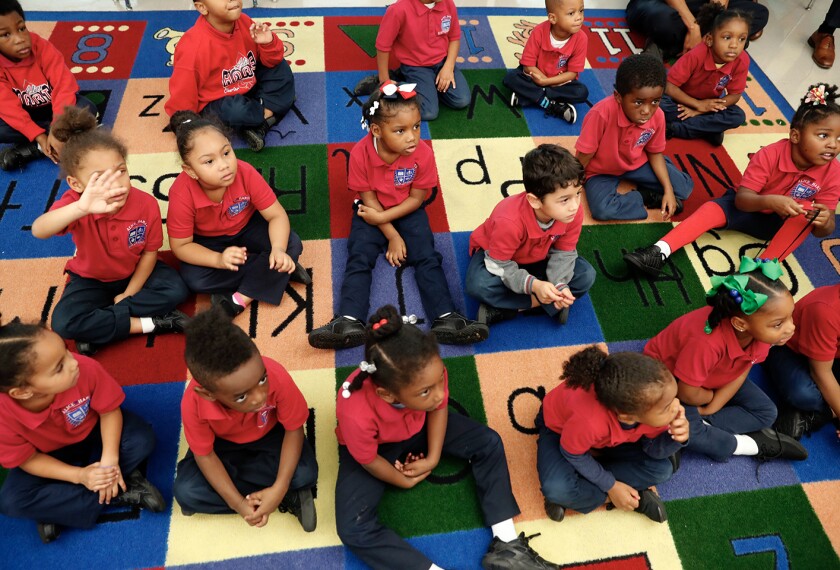Both the positive and the negative effects of spending long hours in organized child care and preschool are evident even after children move into elementary school, two new studies show.
The first paper—the latest from the National Institute of Child Health and Human Development’s Study of Early Child Care and Youth Development—shows that benefits children experience by being exposed to high-quality child care, such as higher mathematics, vocabulary, and memory skills, appear to remain at least through 3rd grade.
The closely watched, federally financed project began in 1991 with a sample of more than 1,300 newborns. This newest research focuses on 972 children who remained in the sample as 3rd graders.
The benefits of high-quality, center-based care apparently don’t extend to children’s social development, says the study. Behavior problems, such as mother-child conflicts and some poor conduct at school, were still detected in 3rd grade among children who had spent more, rather than less, time in center-based programs.
Surprisingly, the researchers also found that some of the negative behavior patterns detected earlier for students in any kind of day care —findings that received considerable attention in the press a few years ago—actually faded by the time the children finished the 3rd grade. In 2001, researchers said that these children were more aggressive and disobedient than other children who had been home with their mothers.
“In some respects, the current findings stand in contrast to our findings prior to school entry,” the authors write in the paper, which appears in the fall issue of the American Educational Research Journal.
But they also caution the public and policymakers against celebrating those dissipating traits.
“Because development is dynamic, we are not surprised that effects are more in evidence at some periods than others,” the researchers write.
In fact, some new negative effects—or “sleeper” effects—that were not detected when the children were younger, such as poor work habits in school among children who had spent more time in child care, showed up for the first time in 3rd grade.
Embracing Good News
Some fear that child care and preschool advocates will play up the finding in the NICHD study that some negative effects fade over time and brush aside the data on problems that remain.
“I just know that there is so much readiness to embrace the good news and so much unwillingness to embrace the bad news,” said Jay Belsky, a psychology professor at Birkbeck College in London and a member of the vast network of researchers on the child-care study.
He also was the most outspoken about the findings four years ago on negative effects and has clashed with others in the network over the conclusions.
After all the time and money spent on the research project—about $10 million a year since 1991—he said he doesn’t think the study has much to offer to the average parent or policymaker trying to decide on child care. Still, he said, the study raises huge questions about how teachers handle classrooms full of children who have spent a lot of time in child care or preschool. (“Study: Quality of 1st Grade Teachers Plays Key Role,” Sept. 21, 2005.)
In the second newly released study, researchers at Stanford University and the University of California, Berkeley, analyzed a much larger sample: more than 14,000 kindergartners from the National Center for Education Statistics’ Early Childhood Longitudinal Study.
As with the NICHD study, the authors found cognitive gains among children, particularly those from the poorest families, who attended a center-based preschool program the year before kindergarten. Because of the sample size, they were also able to see differences between subgroups. While white and African-American children benefited to some extent from such preschools, Hispanic children showed double the gains in early language and pre-reading skills.
But the Stanford and Berkeley researchers, too, found poor social behavior, such as bullying and aggression, and a lack of motivation to take part in classroom activities. Those patterns for former center-based preschoolers were the strongest among white children from high-income families and among low-income black children. Those negative effects did not show up among Hispanic children, but the researchers say it’s not clear why that is the case.
‘Ignoring Their Hearts’
The researchers, led by Susanna Loeb, an assistant professor of education and economics at Stanford, also found that some children, particularly those from middle-class and upper-income families, displayed more behavior problems if they had attended preschool for more than 30 hours a week. For white children, cognitive gains flattened after 30 hours of attendance each week, but continued among black children the more hours they attended.
The authors suggest that policymakers think about whether full-day or half-day preschool classes are more appropriate for certain groups of children as they work to expand state-financed programs with limited resources.
State leaders, they suggest, might also consider whether they are focusing as much attention on children’s social-emotional development as they are on their early academic skills.
Bruce Fuller, an education professor at Berkeley and one of the paper’s authors, said that advocates of expanding preschool to all children might be so focused on “pumping up kids’ brains that they’re ignoring their hearts.”
Libby Doggett, the executive director of Pre-K Now, a Washington-based preschool advocacy group, said that even if poor children benefit more, that “doesn’t mean that middle-income children should be excluded from access to early education.”
“Quality pre-K can no longer be considered a luxury for wealthy families or a targeted program for low-income families,” she said. “America should provide it for all children.”
The Stanford-Berkeley study has been accepted for publication in the Economics of Education Review.



